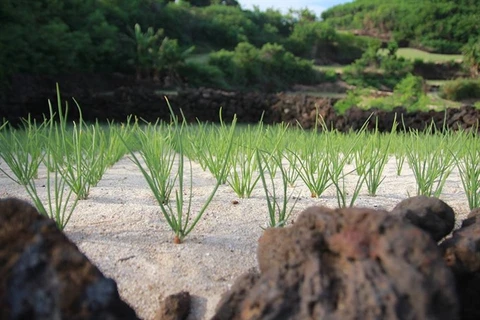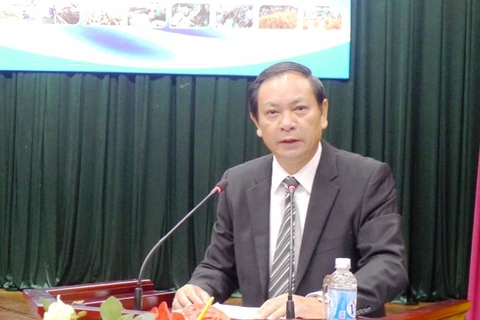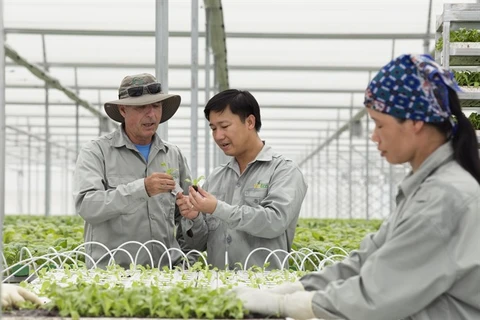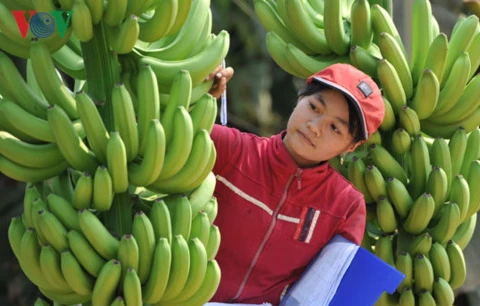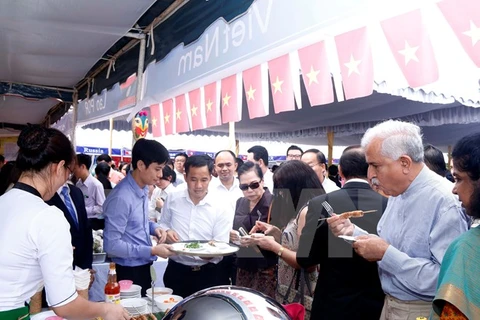Quang Ngai (VNA) – Vietnam’s agricultural sector should focus on developing the economic value of domestic plant varieties by ensuring their output and protecting branding, instead of importing large amounts of other plant varieties. Otherwise, typical and valuable local species will disappear, experts have warned.
The warning was made after the People’s Committee of the central province of Quang Ngai agreed in principle two Japanese businesses to do research and grow Japanese elephant garlic as a pilot on Ly Son Island, which has long been known as the kingdom of garlic with distinctive high-nutrient varieties.
Specifically, Japan-based Nikken Sekkei Civil Engineering Ltd, in cooperation with CAN Holdings – a Japanese company specialising in hi-tech agriculture, proposed to grow elephant garlic on the island and then export it back to Japan.
The plant was introduced as a high-yield and high-value crop. About 4-5 tonnes of garlic can be harvested per hectare, bringing a profit of 180,000 VND (8 USD) per kilogramme for farmers.
Agricultural specialist Le Tien Dung, who is also former head of the Hue University of Agriculture and Forestry’s Agricultural Faculty told Tien Phong (Vanguard) newspaper that the import of another variety of garlic to the island with its small garlic cultivation area could seriously affect the existence and development of local plants.
Dung said Ly Son garlic is a special and distinctive plant that could only be grown in the natural conditions of the island. It took a long time and much effort by local people to select and develop the current variety.
He cited "lonely garlic" which has only one clove as an example. This kind of high quality garlic requires special planting techniques and could be sold at the price of between 1-2 million VND (44-88 USD) per kilo.
If the imported variety was more productive and easier to cultivate, Ly Son garlic would not be able to compete and would gradually disappear, he said.
Ly Son garlic is one of the best varieties with high value that needs to be protected and developed. The problem is all about the protection of typical plants, not about high productivity.
To build a trademark for a local agricultural product was much more difficult. Imported garlic should be planted in places except for Ly Son Island, Dung stressed.
According to the agricultural specialist, there were many lessons about imported plants. Japanese-imported Japonica rice was an example.
Although the rice variety has not been tested and accredited by the Ministry of Agriculture and Rural Development, it was planted on tens of thousands of hectares in the Mekong Delta region. Many hectares of domestic fragrant varieties such as Tam Xoan, Tam Thơm, Lua Huong have been replaced by the imported plant.
Domestic-grown peanuts in the central region are another example. Lac giay, a special peanut variety in Thua Thien-Hue province, has disappeared from the crops of local farmers. It is now preserved in the Hue University of Agriculture and Forestry for gene conservation.
Lac cuc in Nghe An province faced the same fate. Many peanut crops of local farmers have been replaced by Chinese-imported varieties.
Dung said although the State had policies to restore and re-plant local varieties, not all of them could be re-planted successfully or restored back to their origins.
Dang Lien, a garlic farmer on Ly Son Island, said that he did not know anything about the import of garlic to the island and the quality of this variety.
Lien said the cultivated area on the island was restricted. Each person was given 110 square metres for garlic cultivation and many households had to lease land from other households to expand their crops.
If the new imported variety is planted on the island, the area for local products will surely decrease, he added.
Nguyen Van Tien, another farmer in An Vinh commune, said he did not want to try a new variety as the problem was not about productivity.
“My three sao (1,080 square metres) of garlic field has stable productivity of between 1.5-1.8 tonnes, but the price is not stable as it depends on traders, so my profit is not stable,” he said.
Tien said stable and long-term output was what he and other farmers expected most.
Nguyen Viet Vy, Secretariat of the Ly Son Island District Party Committee, said that the warning of the specialist was accurate, and that the provincial authorities need to consider carefully before planting the imported garlic variety on the island.
Vy said so far there was no specific information about the pilot project, so the district could not give further comment.
The district estimates that local farmers plant more than 330 hectares of garlic annually and harvest over 2,000 tonnes, bringing in 200 billion VND (8.8 million USD) for farmers. In April 2009, the brand ownership of Ly Son onion and garlic was recognised by the National Office of Intellectual Property of Vietnam under the Ministry of Science and Technology.
Vy said the productivity of the plant had slightly dropped in recent years, so the district has reported to the province and asked for help from scientists.
The provincial People’s Committee said it had planned to build a factory producing garlic oil with Japanese technology to ensure the output of the plant.-VNA
VNA

